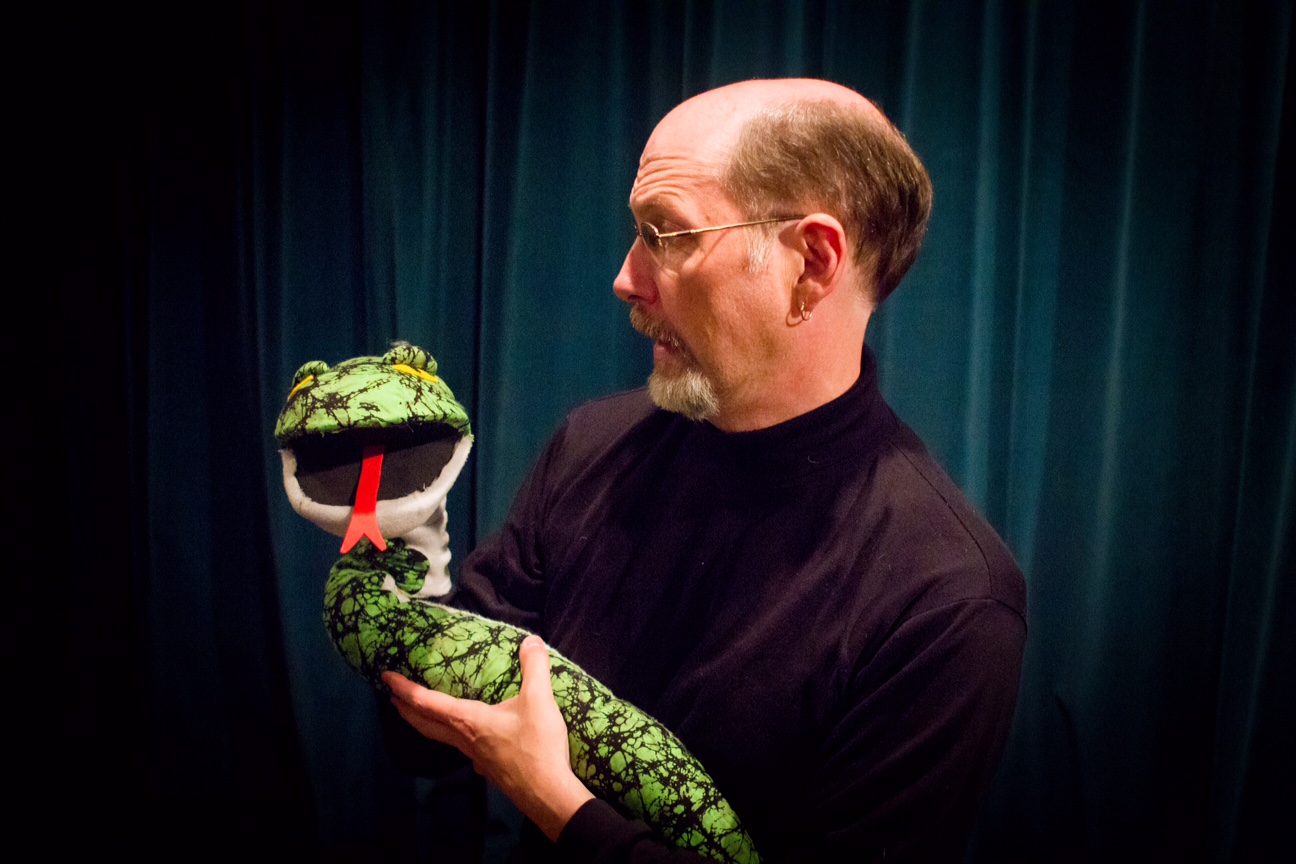
Jonny Gray, writer, director, performer and associate professor of communication studies, presents “The Matter in Hand,” an ensemble performance using puppets, masks and props to help explore the way we define animals and how our definitions color our relationships with them. Gray and his team make the puppets and masks for the performance. Here is Gray with a snake puppet. (Photo provided)
September 18, 2015
‘The Matter in Hand’ takes the stage Sept. 24-26
CARBONDALE, Ill. – It’s not a puppet show but there are puppets in the performance, animal puppets, mainly because the performance is about animals, in a way. Mostly, it’s about humans -- an exploration of the many ways we understand non-human animals, and how our vision of them is sometimes a blessing to them, and sometimes a curse.
Jonny Gray, writer, director, performer and associate professor of communication studies, presents “The Matter in Hand,” an ensemble performance using puppets, masks and props to help explore the way we define animals and how our definitions color our relationships with them. “The Matter in Hand” runs Sept. 24-26 at the Marion Kleinau Theater (Communications Building, second floor), with performances beginning at 8 p.m. Tickets are available at the door an hour before the performance begins; there is no seating once the performance has begun. To reserve tickets (recommended), call 618/453-5618. Admission is $7, $5 for students with student I.D. This is not a children’s performance.
“We share this planet with myriad non-human organisms,” he wrote in his description of the performance. “Sometimes we treat them like our best companions. Sometimes we eat them and use them for labor. When we see too much of our human selves in them, we anthropomorphize them. When we can’t identify with them as fellow beings on the planet, we tend to exploit them.”
For this performance, he’s looking at how we project human qualities onto animals. Biologists strive not to do that, and warn that we don’t understand animals well if we anthropomorphize them, if we attribute to them human qualities and personalities. On the other hand, Gray notes, the animals we can relate to tend to be the ones we care about the most. And yet at the same time, the use of the terms “human” and “animal” seem meant to establish a line between us -- a line that says humans are not animals, even when we know we are.
Gray and several students constructed puppets and masks for this performance. The process began in 2013 when Gray was on sabbatical and decided to revisit his undergraduate training in costume design and theater construction.
“I started making puppets because I was looking for a performance tool to get at questions of how we treat animals,” he said. “After making the first one, I saw the potential of puppets for getting at these questions.”
Gray likes puppets for this performance for several reasons. For one, puppets have a long tradition with the theater, and with shamanism, an ancient and theatrical religious tradition relying on masks and costumes to represent spirit animals and other concepts. He also likes the complexity puppets bring to a performance: we know they are manipulated by a person, and yet we interact with them rather than the puppeteer during a performance. That dual understanding – that a puppet is itself but yet animated by something else – echoes the complexity of the questions about animals Gray’s performance confronts.
“Puppets allow the audiences to see the animal (the puppet, the thing) alongside the means of its construction and animation (the puppeteer),” he said. “That is, puppetry encourages the audience to enjoy simultaneously the construct and the means of its construction. I thought that was a useful way to get at this complicated understanding we have of non-human animals.”
Gray works in two puppet and costume mediums: sewing, foam and fabric construction, and cardboard, paper and glue constructions.
“Making is bonding,” he said. “The puppets I have made are, to me, more alive, more meaningful. I created them, I didn’t just buy them. They are unique… The puppets we make activate us – that is, we are not simply consumers. We are active producers of our lives.”
Making is also problem-solving, a learning curve sort of problem-solving. Gray said each he asks himself, “How do I?” at the outset of each puppet creation. Some construction answers are better than others, he said.
“Most of the puppets I have made are flawed in some way – they don’t quite move right, the neck hole is too tight. I definitely enjoy learning from those mistakes and trying to make the next ones better. But I also love the flaws too. None of us is perfect, after all.”
The puppet construction takes time, and Gray said finding rehearsal time in addition to construction time is a challenge.
“At first, I thought I was working on a solo performance, but the more I educated myself about puppetry and did some puppet projects, the more I realized this was going to be a group performance,” he said. “I created the basic structure of the performance, but the cast and I are ‘writing’ it together. Sometimes that involves writing sometimes it involves improvisation and bodywork on the stage.”
As for Gray’s own relationships with and perceptions of animals, it’s been said of him that “he was raised by cats.” When he was just a baby, the family Siamese cat comforted him when he was still in the crib. The first pet he remembers was a stray black cat. His mother didn’t want to keep it, so she refused to allow the children to name it, calling it “Anonymous.”
“I couldn’t wrap my two-year-old mouth around that word, so I called him ‘Nonnynonny.’ It stuck. That was his name. And he got to stay.”
Today, Gray and his partner have three cats and an aquarium full of fish.
